 He's about to have a growth spurt. 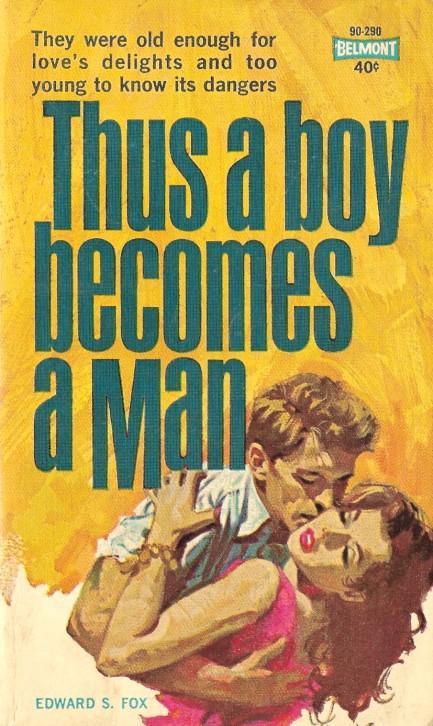
We were unable to learn who painted this Belmont Books cover for Edward S. Fox's 1963 novel Thus a Boy Becomes Man, but it's nice work, possibly a crop and zoom of a larger piece. We vacillated about buying it. We'd never read anything by or about Fox, and we weren't in the market for a simple romance or coming-of-age novel, but in the end we took a flyer, the international mails operated without problems, and the book appeared at our door. It turned out to be a short novel, brief enough to be knocked off in an afternoon, but despite its brevity it was a tale we enjoyed.
The protagonist is young Gil Stuart, who has no experience with women, until two appear in his neck of the Florida Keys—teenaged Georgette and twenty-ish Christine. Georgette is a new Florida resident who lives on a nearby key, while Christine is a seasonal arrival, daughter of a rich Boston railroad executive heading up a project. Both girls are pretty, and both fall for Gil, but he's resistant to them, mainly because he lacks acuity in sexual matters. For that reason, though he's in his early twenties, he feels more like a mid-teen, like a sixteen-year-old. And for that reason, it feels like Fox was shooting for a subtropical Holden Caulfield.
Any book set in the Florida Keys has to be concerned with real estate, seemingly, and this one has a parallel plot about the building of a rail line cutting off bay drainage and subjecting residents to catastrophic flood peril. When appeals to the railroad company yield nothing, some of the conchs decide, as hurricane season approaches, to dynamite the embankment being built for the train tracks. This is a compelling backdrop for Gil's story, as both plot threads suggest that the future—whether bringing romance or trains—is inevitable. Subtle? Maybe not. But it basically worked, faux Caulfield and all.
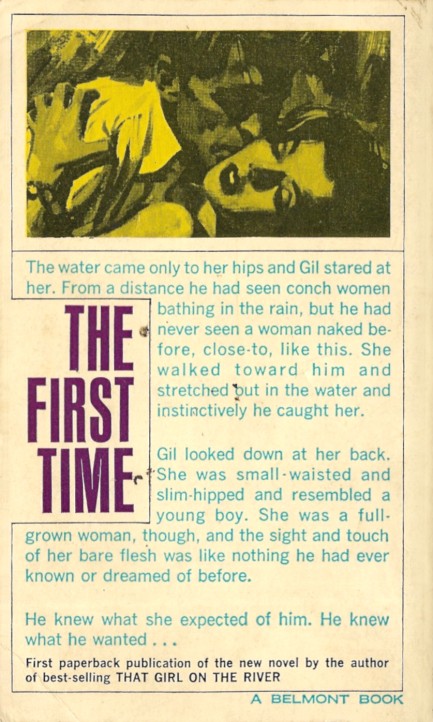
 My medical advice is to spend the rest of the night in bed. Let me just phone down to the desk because I'll need an early wake-up call. 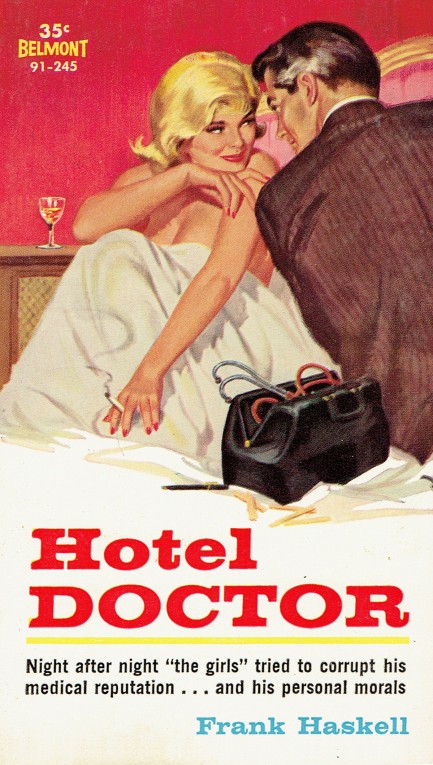
Another lecherous physician stars on this cover for Frank Haskell's Hotel Doctor, published in 1954 by Belmont Books. We've been documenting these over the years, and if you actually have the patience, you can see some of them here, here, here, here, here, here, here, here, here, and here. We have others, as well, but there can't possibly be time for you to look at them all. We know. We should make a keyword for these. We will, we promise. Haskell was aka Haskel Frankel, and when he wasn't authoring novels was a theatre critic and ghost writer. Hotel Doctor was also published by Carnival Books and Venus Books, so it must have been pretty good. The art is uncredited.
 Citywide virus lockdown continues, with exceptions made for essential workers. 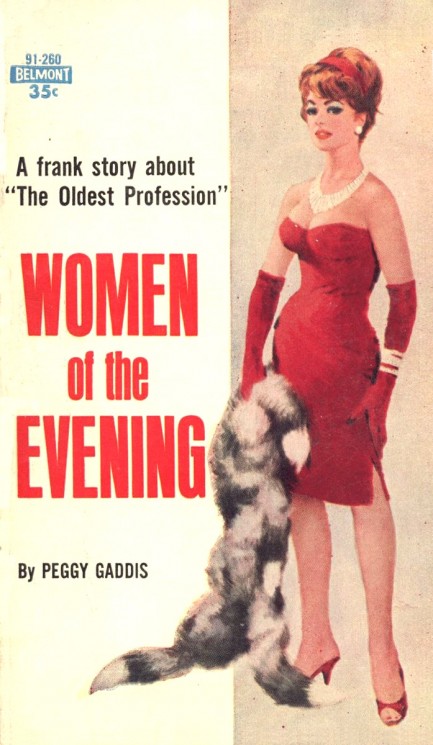
Who constitutes an essential worker is really a matter of opinion, isn't it? In pulp terms, a city without vice can't claim to be a functioning city at all. And since they say prostitution is the oldest profession, it follows it would be the last to shut down. Brothels in various cities are now requiring customers to wear masks when having sex, and the international gimp crowd is like: “Right? You see? It's hella fun. You should try it with leather.” We wonder what happens when the brothels run out of masks (The international gloryhole crowd is like, “You can't guess? Really?”). You won't find any such dickulous variations in Women of the Evening, written by Peggy Gaddis and published by Belmont Books in 1962. In fact, you won't find much sex at all, if our previous Gaddis experiences are an indication. We just finished a Gaddis a few days ago—Once a Sinner, which she wrote as Gail Jordan—and it was more like a romance novel. Well, we'll keep looking. She wrote not only as Gaddis and Jordan, but as Peggy Dern, Sylvia Erskine, Roberta Courtland, Perry Lindsay, et al. One of those alter egos has to be the dirty version of Peggy. We'll find her. She can't hide. Not from us. See more from her extensive bibliography here, here, here, and here.
 The Sugar high doesn't last. 
This eye-catching cover for Adam Knight's 1960 mystery novel Sugar Shannon was painted by an uncredited artist. The image lured us toward a purchase, and reading the book we immediately discovered that the main character is supposed to be a sort of Honey West clone. We didn't think much of This Girl for Hire, the book that introduced West to the world, so a derivative version was probably never destined to thrill us. And indeed, the whole thing—which involves the title character and her sidekick Gwen trying to solve two murders in the New York City art underground—is pretty silly, and more than a little condescending. For instance, Knight makes constant references to Sugar's “girlish instincts,” “womanly intuition,” and “feminine corpuscles" (huh?), suggesting his investigative reporter heroine works less by logic than by a sort of gender-based magic. Sugar Shannon was supposed to be the first book of a series, but it turned out to be a series of one. That says it all.
 While part of me believes your claim that you're an A+ in bed, another part of me is skeptical because you're a consistent D in class. 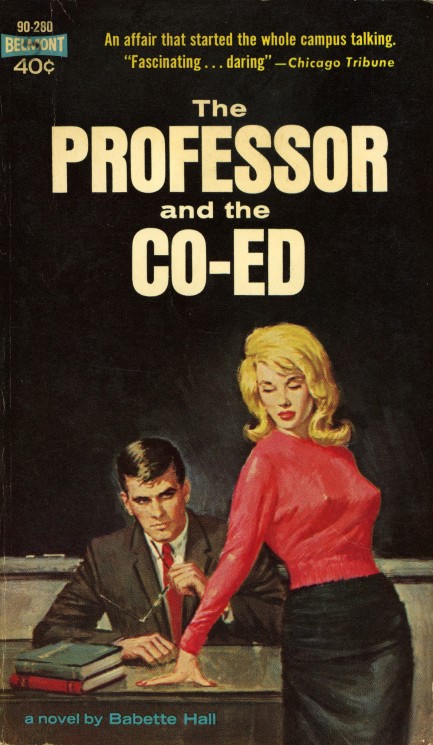
It's sleaze so nice they published it twice. The 1960s was the heyday of student/teacher sleaze novel, but even in that receptive era Babette Hall's The Professor and the Co-Ed must have sold especially well to warrant a new run. Hall really deserves credit because, amazingly, this was even published a third time—way back in 1946 as Last Night When We Were Young. 1946 books weren't terribly daring on the whole, so it's safe to assume this isn't sleaze at all, but a deliberately misleading rebranding, greatly helped by art from Robert Maguire at top, and an unknown on book two. The copyright is 1963 and 1967 on these.
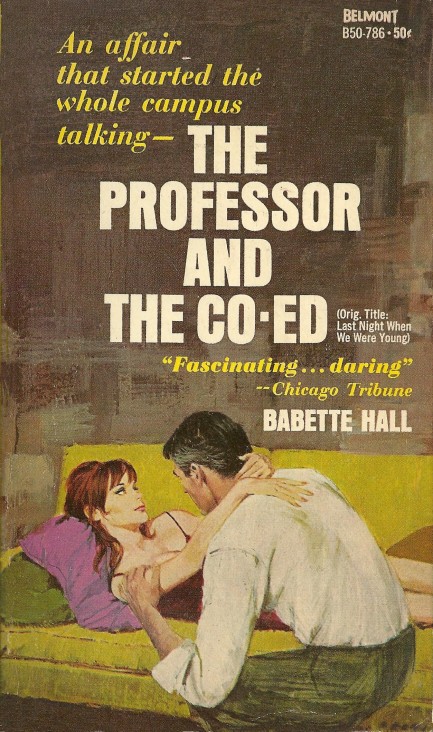
 Step away from the controls, men. You've had your shot at running the world and the results speak for themselves. 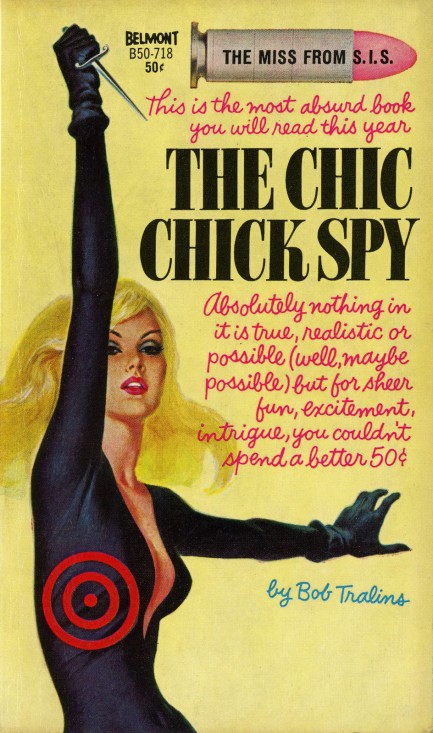 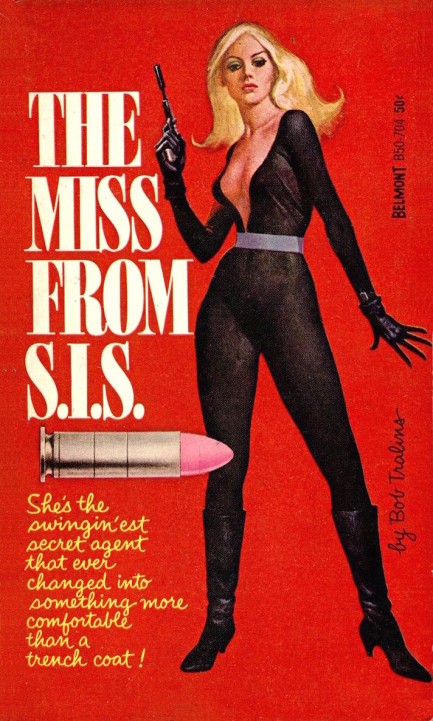 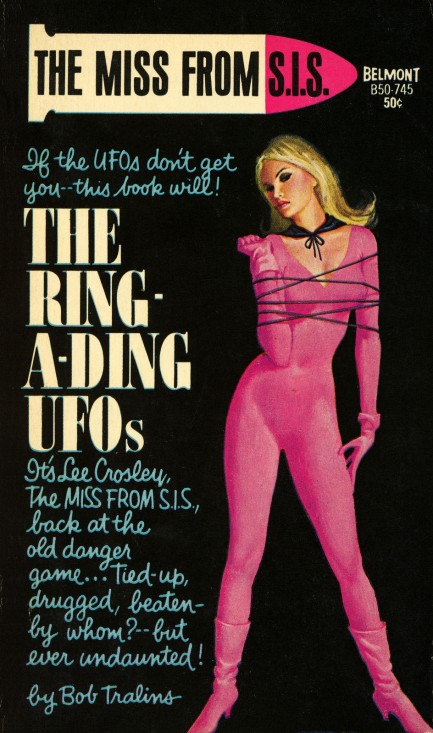
The James Bond book and movie franchises spawned an army of literary and cinematic spies with numerical and acronymic designations. The film we talked about yesterday is a good example, and 1964's television show The Man from U.N.C.L.E. is another. Author Bob Tralins joined in the fun in 1966 with his creation The Miss from S.I.S. The letters stood for the Society for International Security, and the group consisted of women—particularly lead spy Lee Crosley—cleaning up the mess men had made of the globe. Above you see the three entries in the series with their great cover art that is, amazingly, uncredited. We'll keep digging for info. In the meantime, more Bob Tralins here.
 It’s kill or be killed. 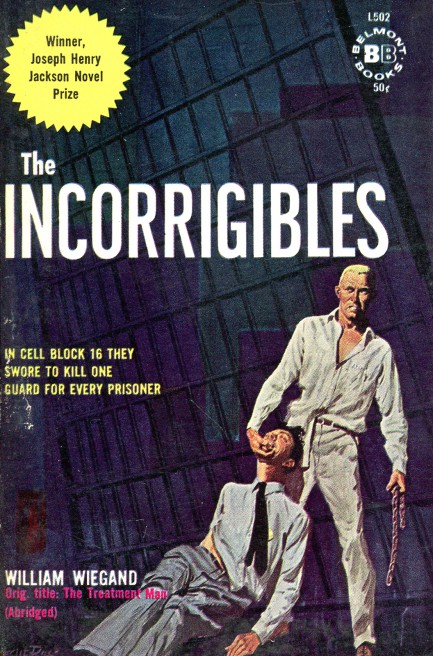
Above, unusually gritty cover art by A. Leslie Ross for William Wiegand’s 1960 prison riot novel The Incorrigibles, first published in 1959 as The Treatment Man. Inspired by the Jackson, Michigan prison riot of 1952, the original title gives a clue to the novel’s contents—a psychologist who believes in rehabilitation is confronted by a riot in what had seemed an orderly prison. Good men are defeated and ulterior motives emerge. As the cover says, the book was an award winner.
 Silly boys. I wonder if they'd be fighting if they knew that no matter who wins I'm going to lei them both. 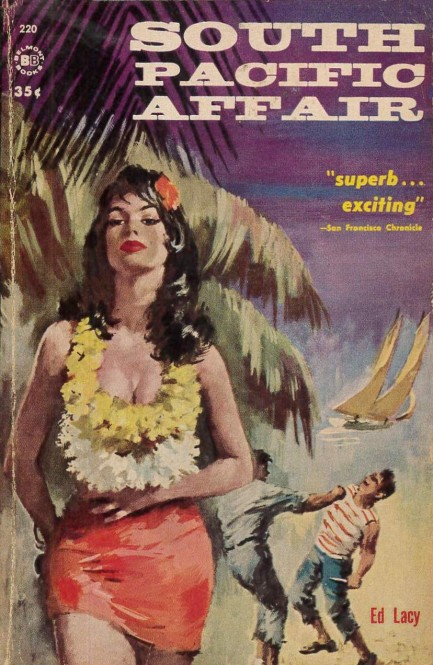
This cover for Ed Lacy's 1960 novel South Pacific Affair makes us suspect artist George Ziel was thinking along the same lines as us—i.e. it's interesting that he painted the island woman with two leis around her neck. Here's a fun fact: while we know several people, us included, who've come to the physical defense of women in danger, we don't know a single man who's ever fought due to romantic rivalry. We asked around. Nobody admitted to it. Is it generational? Every woman we know would stop this fight in its tracks with: “Hey! Idiots! I'm not a 24-pack of Coors! I choose, and it's neither of you!” But the cover misleads, as they sometimes do. There's no literal fight over a woman. There's a fight over a sexual betrayal, but the catalyst is years in the past and 7,000 miles away.
We've read a few Ed Lacy books, and all of them have been about crime and graft in urban settings. South Pacific Affair expands his field of interests to the classic fantasy of life in paradise. Ray Jundson is an American living on the fictional French Polynesian island of Numaga who can't see the beauty of his circumstances. He's torn between staying there, continuing to sail from island to island trading goods, and marrying his island sweetheart Ruita, or letting his wanderlust and desire for riches carry him away toward unknown solo adventures, possibly even back to the U.S. Frankly, for a man with everything he's way too jaded for realism, but you have to follow the author's lead.
We don't know if Lacy ever went to French Polynesia, but the details read as if he did. That's good, because other than travelogue, nudity, and a lot of soul searching by Ray, nothing much happens in the book until, more than halfway through, a smallpox outbreak brings on a countrywide quarantine. One captain defies the law, sails from Papeete to Numaga, and tries to offload passengers, while downplaying the severity of the disease. That's on-the-nose for 2020, don't you think? Turns out he's actually trying to jettison a group of advanced cases and Ray is one of the people fate places in a position to stop this deadly maneuver.
This is Ray's first motivated act in the entire book, but fortunately not his last, which means the final third of the story gets interesting. Too bad that newly found motivation leads him to set up a scam involving a fake Polynesian princess, credulous American tourists, and the island equivalent of pimping. It may sound farfetched, but we can tell you from personal experience: spend enough time on a tropical island and anything can seem like a good idea. South Pacific Affair isn't Lacy at his best, but for knockaround guys like us, it was pleasantly familiar. Overall, we think it's worth reading for its unusual status in the Lacy bibliography. But we offer no guarantees.
|
 |

The headlines that mattered yesteryear.
1939—Batman Debuts
In Detective Comics #27, DC Comics publishes its second major superhero, Batman, who becomes one of the most popular comic book characters of all time, and then a popular camp television series starring Adam West, and lastly a multi-million dollar movie franchise starring Michael Keaton, then George Clooney, and finally Christian Bale. 1953—Crick and Watson Publish DNA Results
British scientists James D Watson and Francis Crick publish an article detailing their discovery of the existence and structure of deoxyribonucleic acid, or DNA, in Nature magazine. Their findings answer one of the oldest and most fundamental questions of biology, that of how living things reproduce themselves. 1967—First Space Program Casualty Occurs
Soviet cosmonaut Vladimir Komarov dies in Soyuz 1 when, during re-entry into Earth's atmosphere after more than ten successful orbits, the capsule's main parachute fails to deploy properly, and the backup chute becomes entangled in the first. The capsule's descent is slowed, but it still hits the ground at about 90 mph, at which point it bursts into flames. Komarov is the first human to die during a space mission. 1986—Otto Preminger Dies
Austro–Hungarian film director Otto Preminger, who directed such eternal classics as Laura, Anatomy of a Murder, Carmen Jones, The Man with the Golden Arm, and Stalag 17, and for his efforts earned a star on Hollywood's Walk of Fame, dies in New York City, aged 80, from cancer and Alzheimer's disease. 1998—James Earl Ray Dies
The convicted assassin of American civil rights leader Martin Luther King, Jr., petty criminal James Earl Ray, dies in prison of hepatitis aged 70, protesting his innocence as he had for decades. Members of the King family who supported Ray's fight to clear his name believed the U.S. Government had been involved in Dr. King's killing, but with Ray's death such questions became moot.
|

|
|

It's easy. We have an uploader that makes it a snap. Use it to submit your art, text, header, and subhead. Your post can be funny, serious, or anything in between, as long as it's vintage pulp. You'll get a byline and experience the fleeting pride of free authorship. We'll edit your post for typos, but the rest is up to you. Click here to give us your best shot.

|
|
























































































